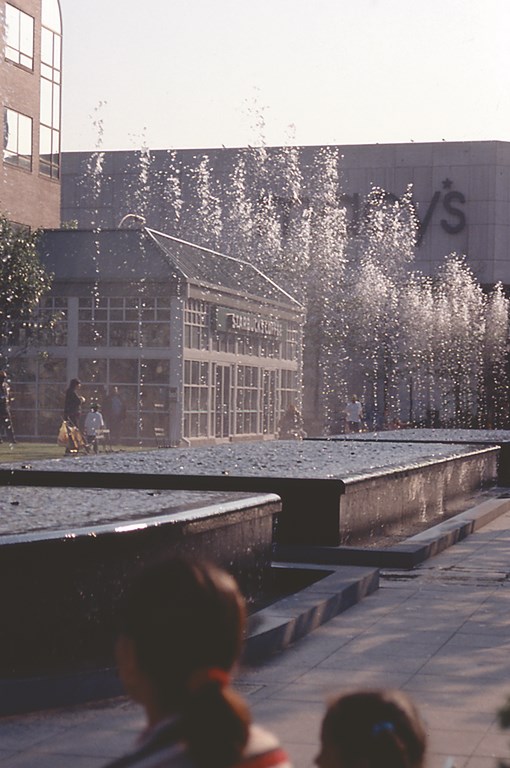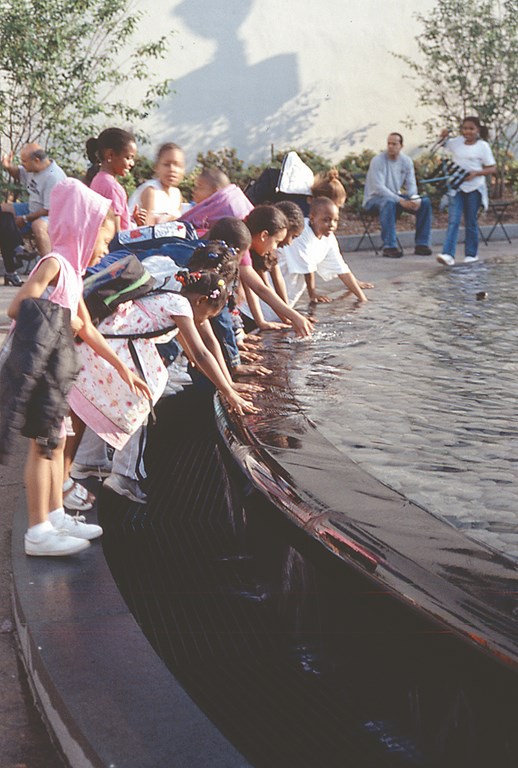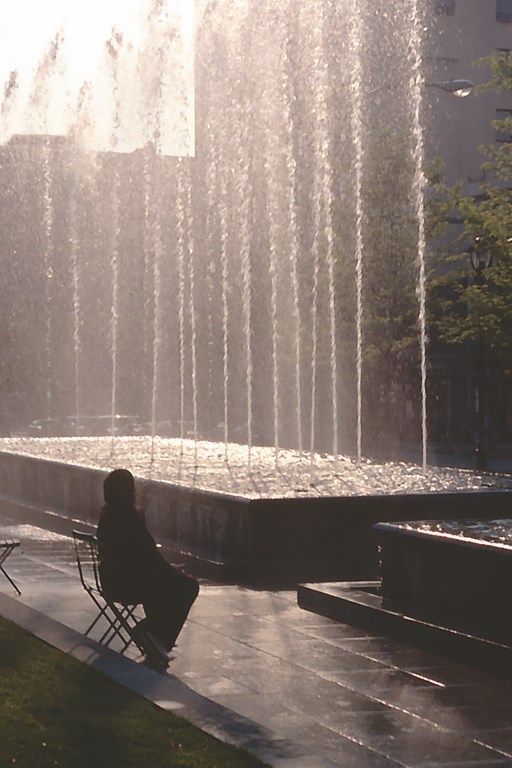When Music Meets Water

At a time when scores of American cities are still looking for ways to revive the faded glory of their urban cores, possible approaches are as visionary (and numerous) as can be. The process has resulted in new parks, major redevelopment, architectural restorations and a long list of other solutions – including the unique watershape commissioned by the city of White Plains, N.Y.
A town with 54,000 full-time residents whose population swells to more than 200,000 during the day when office workers, shoppers and visitors come calling, White Plains made the decision to invest $4.5 million of public and private grant money in resurrecting a small downtown park.
Appropriately named Renaissance Plaza, the park surrounds a state-of-the-art musical fountain unveiled in October 2003 for the specific purpose of luring people back to the downtown area – and it has worked. In fact, the plaza has become such a hub of activity that nearly 1,700 units of new residential housing are now under construction in its downtown neighborhood.
URBAN OBJECTIVE
First settled by British colonists who bought it from the Mohican tribe in 1683, this historically rich city located 25 miles north of Manhattan has truly been reborn, and it’s with no small measure of pride that our firms, Aquatic Design & Engineering (Orlando, Fla.) and Crystal Fountains (Toronto, Ontario, Canada) played key roles in that transformation with our work on its musical fountain.
The city’s aim was to create a landmark that would attract people as well as investment, renovation and new development. At the time the city agreed to transform the existing space – an overgrown and wholly unappreciated park – into a center of interest and excitement, they believed that the watershape was the key not just to the park itself, but would also serve as a visual focus for all the changes they envisioned around it.
To drive the project, the city contacted Alan Ward, principal of Sasaki Associates (Boston and San Francisco), the internationally recognized landscape architecture/urban planning firm that is currently designing the 2008 Olympic Park for Beijing.
| NEIGHBORHOOD CONNECTION: Tucked into a small space amid buildings of assorted heights, the musical fountain was intended to draw people to its park – a key to the revitalization of the downtown district. |
What Ward found in White Plains was an old park hemmed in on the footprint of a building that had long since disappeared. Measuring just 70 feet wide and 200 feet long, it was not much area to work with, but Ward and his design team were inspired by research done on the characteristics of successful urban parks and what it said about a liveliness and vitality that develops when small spaces are used wisely.
Ward accordingly planned on taking advantage of the park’s unlikely setting, designing the plaza to break the high-rise monotony that surrounded it through use of a great deal of greenery and to exploit its position at the intersection of the city’s two main streets with an appropriate watershape.
| SPLASH ZONE: When the show’s not running, the water in the multiple pools becomes an irresistible magnet for children, who basically do what comes naturally in taking a hands-on approach to the experience. |
The water was seen as opening and maintaining clear lines of sight through the space. It was also seen, because of our natural human attraction to water, as a means of drawing people to the heart of the plaza. As they considered their options, Ward and city officials became increasingly intrigued by fountains and the potential they had to turn water into theater through use of sequencing effects.
As a first step, Ward contacted Ken Martin of Aquatic Design & Engineering (ADE), which has a distinguished record in projects for Walt Disney World, Universal Studios Florida and various Marriott and Hyatt properties – and which had worked with Sasaki Associates on the Golden Moon Casino & Resort in Mississippi.
As design engineer for the watershape, Martin suggested the use of music to animate the space even further and persuaded Ward that the water-switch technology offered by Crystal Fountains would help meet the city’s lofty objectives for the park.
NO SMALL TRICK
All musical fountains are one-of-a-kind installations, but this type of nozzle had never before been used in such quantity in so small a space. We also had to work with winds that whip around the high rises in such a way that cars passing on the busy streets wouldn’t be splashed. And finally, there was the timeline: We
were commissioned to do the design and engineering in December 2002, started construction in March 2003 and had to be ready by October of that year.
Breaking the project down into tasks was the only way we could ensure that each phase would go smoothly. We immediately tackled the hydraulic engineering, knowing that excellent piping designs, trouble-free nozzles and easy operation and maintenance would all be crucial.
| MAJESTIC HARMONIES: The fountain and its music invite people to sit, relax, watch and listen, just as intended. The control system responds to prevailing wind conditions, lowering the height of the jets to limit overspray. |
The water switch selected for the project pulses at a rate of 10 times per second – a critical requirement when the goal is choreography to music. Each switch is mounted directly to the fountain nozzle in the vessel and provides fast, dynamic sequencing patterns without complicated pneumatic and hydraulic controls.
The switch itself is actually a water diverter; meaning it changes the path of water from a nozzle port to an exhaust port rather than cutting off the flow altogether. A small solenoid controls the atmospheric air on either side of water flow, causing the flow to “bend” in the direction of either the nozzle or the exhaust port.
This design offers fast sequencing response without causing “water hammer,” an annoying banging sound in piping systems. Because it only diverts water flow, the pump and piping system experience no pressure changes of the sort experienced with devices such as diaphragm valves. Perhaps most important of all with respect to reliability and maintenance, the submersible water switch has only one small moving part and comes with a 10-million-cycle rating.
We further delivered on the city’s request for ease of operation and maintenance by designing the feature with completely automated systems. For example, the fountain self-regulates in response to changing environmental conditions: If the system detects increasing winds, it lowers the height of the water plumes to reduce overspray. In addition, if a pump malfunctions and the water flow becomes irregular or if a filter needs cleaning, the system notifies the operator.
| LOOKING GOOD: In full flow, the fountain’s impressive display dwarfs all onlookers, some of whom don’t seem concerned by the possibility that overspray is likely to give them a bit of a soaking. |
Similarly, given the huge number of underwater lights in the White Plains feature and the fact that they’re not so easily changed, we reduced maintenance time by recognizing the fact that bulb life is shortened by repeated on/off cycles. Instead of using on/off switches, we put the lights on dimmers (1% to 100%) so that when light patterns change as part of the display, no lights are actually turned off. As a result, the lights are turned on only once per day and turned off at midnight, extending the life of the bulbs and reducing costs.
WISDOM TO SHARE
With the various technologies in place at least on paper, it was time to make certain that everyone involved with the project shared the same vision of the finished watershape.
On this project, we secured that vision through joint effort of the client, the design team and the engineers, all working together. We showed video clips of the water-switched nozzles in operation and reviewed past projects (particularly those on which ADE and Crystal Fountains had worked as a team), but the key, particularly for the client, was playing music along with the moves of other waterfeatures – a preview that gave the city a vivid look into its future.
| NIGHT VISION: When night falls, the fountain kicks into higher visual gear courtesy of the 160 lights arrayed throughout the basins – a reward to those who venture downtown after dark for a bit of music-accompanied shopping. |
This step was also important with respect to managing client expectations and making certain they were expecting what we could effectively deliver. With this shared vision, we were all working toward the same goal.
The scale of the Renaissance Plaza fountain is similar to those typically found with hotels or casino properties, but we all had the feeling this was something special because of the unique urban setting. The fountain features four shallow, raised pools with pedestrian paths in between. Indeed, people can walk into the heart of the feature and can’t see the nozzles or other fountain equipment, all nicely hidden under six inches of water.
|
Keys to Success There were many keys to making the project described in the accompanying text come successfully to fruition, including the availability of the water-switch technology; our awareness that we had to avoid any high-maintenance devices; a shared vision that saw everything having to do with the fountain as being an artistic expression; and a common understanding that the nature of the project meant long hours. Perhaps most important to our ultimate success, however, was the fact that we had in the City of White Plains an ideal client, one who trusted and empowered the entire design team. In this case, the city had been on a quest for some years for a fountain feature that would put White Plains back on the map. Civic leaders wanted a reason for people to come downtown and brought a level of commitment to the project that helped it move forward quickly and easily. In addition, citizen groups joined in and helped get the entire city excited about what was happening downtown. Their enthusiasm definitely helped motivate us – something we needed in order to complete such an elaborate project in just about five months! — K.M. & G.T. |
The fountain system operates with a total of 48,000 gallons of recycled water. Seventy-five jets spout water 15 feet in the air, two dozen more shoot up 25 feet and three superjets propel water as high as 60 feet into the air – higher than any of the immediately adjacent buildings. There are also 13 giant leaper jets that shoot water from one pond to another as well as a fog machine, more than 160 lights and six water pumps.
It’s been described by many observers as a “tactile” fountain. Children especially love to touch the water, and there’s a lovely reflecting pool that overflows into troughs, producing a gentle sound when the jets are at rest. It’s a peaceful environment at those times, but when showtime comes, it’s an entirely different story.
The fountain has a regular schedule of water shows during lunch hours and each evening. The shows last from three to five minutes and run every 20 minutes. Since it’s been in operation, we’ve been told that the patriotic songs in the repertoire have been known to move veterans to tears.
THE SCIENCE OF CHOREOGRAPHY
When the proposed number of songs increased from the original four to 20, we had to stare down an unbelievable programming task. Integrating all of the nozzles and the potential different looks and varied rhythms fell to Crystal Fountain’s choreography and programming team, which delivered routines of tremendous power and finesse.
It helped that Crystal Fountains supplied all of the technology and equipment for the musical fountain, including the sound system, computer controllers, lighting technology and fountain components. The choreography and programming team knew the technologies inside and out, which greatly accelerated the process of delivering results on the plaza.
To illustrate the amount of work involved, it took the team a total of 14 24-hour days to choreograph all of the songs and then program them into the fountain system. The process was not unlike preparation for a major theatrical production, where weeks and even months of planning go into seamless on-stage performances.
| MAGIC MOMENTS: The City of White Plains was after a watershape that would become a focal point for downtown pride and energy, and water moving in time to music seems to be working exactly as hoped and planned. |
In fact, we began the process by “storyboarding” the songs, planning the look of each stanza by sketching the roles of each jet. To stretch the show-business analogy just a bit farther, it’s like preparing for a ballet or opera in which the jets are the dancers and we’re guiding their steps. We directed when the jets were used, their frequency, speed, heights and interactions with other jets, and we always, always had to consider how long it would take the water from the jets to respond so they’d appear to be moving in time to the music.
To that extent, musical fountains are 50% about the water and 50% about the timing. We’d pore over musical scores and spent hours listening to recordings, over and over and over again. We tried different things, ran through permutations and combinations of possible effects and worked until we had what we saw as the best possible results – a process complicated by the fact that all the final work happened on site and by the fact that the space was small and everything was being seen in such unusually close quarters.
All in all, watching water perform is truly amazing, and we all see creating musical fountains as taking an already beautiful art form to the next level. Yes, it’s an expensive art form, but the proof is in the pudding: Once you see such a fountain and perceive how much the sound enhances the experience, you’ll be as hooked as we are by these tuneful combinations of music and water.
Ken Martin is a principal at Aquatic Design & Engineering (ADE) of Montverde, Fla., and has more than 26 years’ experience in the design, engineering and construction of watershapes across a range of project types. In addition to holding a degree in business administration from the University of Central Florida, Martin is also a 1984 graduate of the Harvard School of Design and has earned a reputation for strong designs and problem-solving on complex projects at resorts and theme parks throughout the eastern United States and the Caribbean. Gerald Tester is a project manager for Crystal Fountains of Toronto, Ontario, Canada. Tester’s background is in the music industry, and he often participates in projects requiring the coordination of music and fountain effects. After studying theatrical production, his first position was with the Canadian Opera Company. For the next 15 years, he worked in lighting, sound and video for live entertainment with performers as diverse as Bare Naked Ladies and Roger Whittaker before joining Crystal Fountains.




















